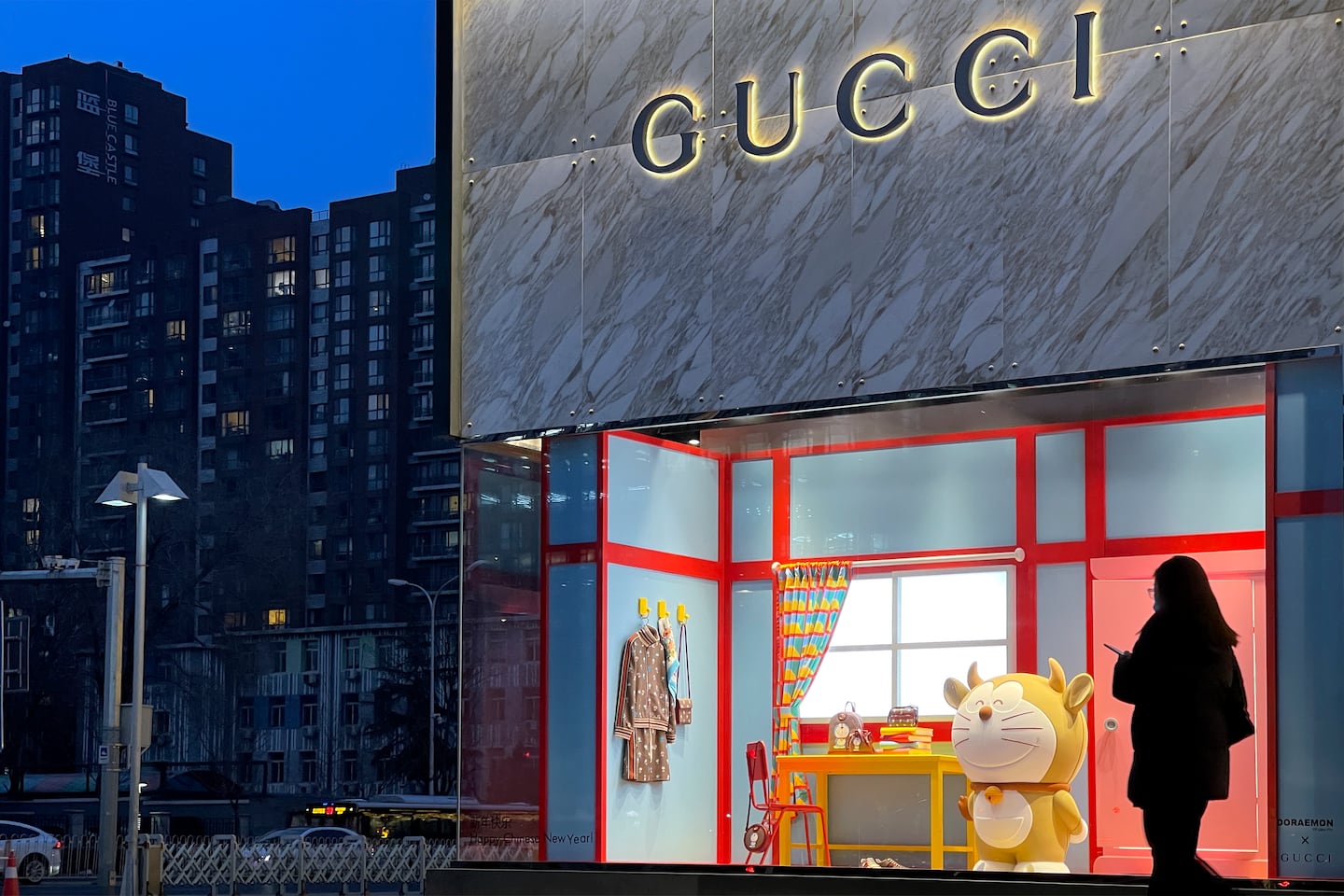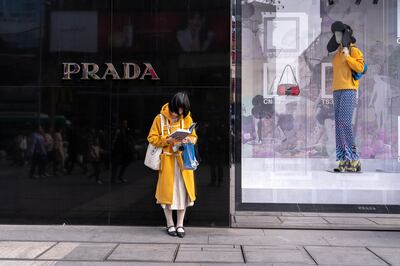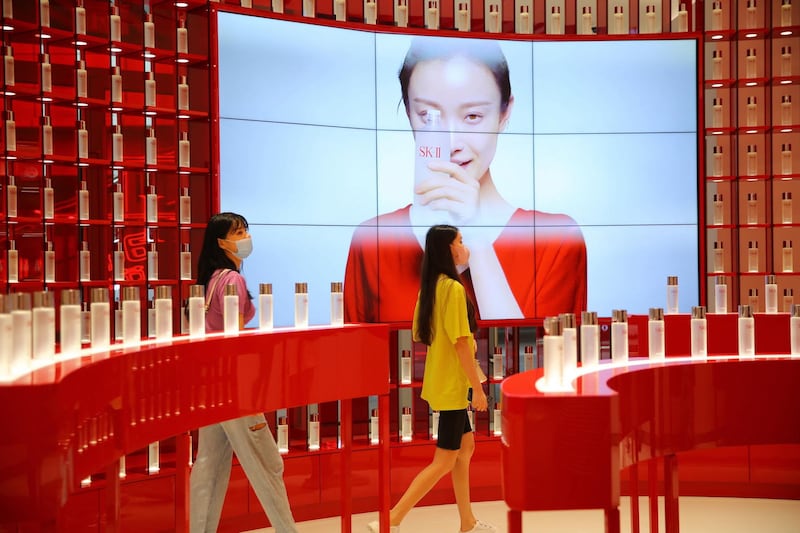
The Business of Fashion
Agenda-setting intelligence, analysis and advice for the global fashion community.

Agenda-setting intelligence, analysis and advice for the global fashion community.

Before the Covid-19 pandemic halted international travel for Chinese consumers, Yvonne Ching shopped mainly when she travelled the world for work or leisure. But a halt in her previously busy international travel schedule hasn’t stopped her shopping for luxury goods.
“I feel like I have definitely been shopping more this year; my friends have as well,” said Shanghai-based Ching, who is also a fashion influencer (known locally as a Key Opinion Leader, or KOL). “In the malls, I’ve noticed there is way more traffic than there used to be, the malls are packed on the weekends.”
Urbane and fashionable women like Ching, from China’s top-tier cities, are the ones international luxury brands are most used to serving, and they’ve been central to booming local sales since the worst of the country’s coronavirus outbreak passed last spring. But they are only one part of a complex and layered puzzle that needs to be decoded in order for luxury brands to unlock the opportunity of Chinese clients reshoring their purchases.
With sales to Chinese people accounting for one third of revenues and more than two-thirds of the industry’s growth before the pandemic, it’s difficult to overstate how important it is to recapture consumers who previously shopped overseas.
ADVERTISEMENT
The job is far from over: luxury sales in mainland China rose by 45 percent last year, according to consultancy Bain, but while China was the best performing country, sales to Chinese people worldwide actually fell by 30 to 35 percent, compared with just a 10 to 15 percent drop for European consumers.
With China’s luxury consumption trapped within the mainland again this year, and possibly for longer, it’s critical for brands to identify potential customers, establish direct relationships with them, and understand what drives their purchasing decisions.

“There is just so much wealth within China and different layers of consumers, different ages, different careers, different wealth levels, city tiers and regions. There are a lot of layers to luxury consumption in China and during Covid, that has really come to the surface,” explained Amrita Banta, managing director at Agility Research & Strategy.
“A lot of new luxury consumers have come into play in China post-Covid, it’s not only the classic consumers that you would expect,” she added.
Reaching the Tier-Three Businessman
There has been a lot of buzz about China’s new generation of consumers, the Post-90s and Post-00s demographics between the ages of 20 and 30 with significant disposable income thanks to the wealth acquired by their parents.
Data backs up the growth in younger consumers spending on luxury with research from Tencent and BCG showing the average age of luxury consumers in China is 28-years-old — a full decade younger than the average age of those in most other parts of the world.
Understandably, luxury brands have pulled out all the stops in trying to appeal to this demographic, embracing their favoured social media platforms (such as Bilibili and Douyin) and innovations (such as livestreamed e-commerce) and joining forces with their favourite celebrities (Jackson Yee, Wang Yibo, Cai Xukun) for brand ambassadorships.
ADVERTISEMENT
But there is another luxury consumer profile in China that is far less heralded than the Gen Z kind.
Banta describes the typical profile of this group as being 40-something businessmen from second-tier and third-tier cities, who have seen their wealth increase dramatically along with China’s economic rise in recent years.
In the fourth-tier cities, the male consumer of luxury goods becomes more prominent and the products they buy are different as well.
“This strongly growing source of luxury consumers … buy for their wives and children, actually also quite a lot for themselves and gifts for business associates … they like to buy luxury and make that statement to show off their wealth,” she explained.
Zhang Tianbing, Deloitte Asia Pacific Consumer Products & Retail Sector Leader, says that in lower tier cities, it’s really men who are leading the way when it comes to growth in luxury consumption – bucking the idea of Chinese luxury consumers primarily being in the Yvonne Ching mould of affluent, first-tier women.
“In the fourth-tier cities, the male consumer of luxury goods becomes more prominent and the products they buy are different as well,” he said, pointing to shoes, watches and electronics as key categories for these consumers.
In some ways, this new generation of lower tier consumers can be thought of in a similar vein to the first wave of Chinese luxury consumers, with attributes including a focus on big brands and logos playing a larger role in decision-making.
For brands who are used to having these newly minted millionaires and their families come to them on tours of Europe and the US, reaching them back in China is a key challenge. New stores in lower-tier cities can help — as will upgrading and freshening the offering of flagships in first-tier hubs. Cities such as Shanghai, Beijing and Chengdu are likely to remain heavily-touristed destinations for lower tier consumers unable to travel internationally for the foreseeable future.
Understanding Daigou’s New Era
ADVERTISEMENT
Long thought of as a thorn in the luxury industry’s side, the daigou seller’s grey market has long been fuelled by tax rebates and price differences for luxury products, which have historically been much more expensive in China than in other markets.
Since daigou’s share of the market has declined in recent years and international travel is now at a near standstill, one might expect it to be over for good. Not so: like luxury spending in general, the daigou market is rapidly reshoring, with resellers taking advantage of lower prices on the duty free island of Hainan to cater to value-seeking Chinese customers on the mainland.
Total sales of duty-free goods in Hainan reached 27.48 billion yuan ($4.26 billion) in 2020, a year-on-year increase of 103.7 percent, with the number of individual shopping trips increasing by 19.2 percent to 4.48 million, according to the General Administration of Customs.
Though many sales in Hainan are being made to traveling Chinese consumers starved of international beach-side destinations for their holidays, the re-shored daigou trade is also responsible for a significant share.
According to a Re-Hub survey of daigou goods and transactions on Chinese marketplaces conducted in 2020, the biggest luxury brands dominated, with Louis Vuitton, Chanel, and Gucci accounting for 44 percent of the luxury handbag market on Taobao. Louis Vuitton bags alone represent 24 percent of the daigou market for luxury bags, the study said.
[Some] daigou consumers are more mature and sophisticated and [not driven by price at all]”
Still, daigou has been evolving. Re-hub’s Chief Client Officer, Yoyo Liang, estimates that as much as a third of daigou consumption today is driven by demand for unique and limited-edition products, even if they are priced higher than they would be in a Chinese store.
“There is a pre-conception in the market that the price-sensitive consumer is still the dominant one but [another segment] of these daigou consumers are more mature and sophisticated and [not driven by price at all],” she said.
The resilience of daigou as clients become more sophisticated and as the price gap between China and other markets has narrowed could point to the fact that convenience, selection, and salesmanship all play a role in the secondary market — not just price. Personal shoppers foster relationships and dialogue with their client communities — and luxury brands will need to surpass those service levels if they want to recapture daigou clients locally.
Which Brands Are Winning and Why
Unsurprisingly, the biggest and most iconic brands have been most adept at capitalising on the trapped Chinese luxury consumption. Hermès, Louis Vuitton, Dior and Prada have all done well with their high-priced leather goods offerings, in particular, followed by ready-to-wear collections leading to explosive mainland China growth in the second half of 2020.
Hermès was a notable winner in China. Asia (excluding Japan) was the brand’s only region to grow for the full year, with sales rising 14.4 percent. Sales in the region accelerated in the fourth quarter, jumping by 47.4 percent.
LVMH reported fourth-quarter growth of 21 percent in Asia (excluding Japan), as rapid growth at its Louis Vuitton and Dior labels helped offset difficulties in its luxury beverage division and DFS travel retail chain.
“The gap between the big iconic names and the smaller brands has definitely increased post-Covid. The demand for the classic, iconic brands and within these brands, their iconic signature classic product lines is obvious,” Banta said.
These brands, Banta adds, have the advantage of attracting the new luxury and entry-level luxury consumers whose first foray into luxury is usually via its biggest names. But they also have a history with established local luxury consumers who are now going to the next level by investing in higher-priced limited-edition products, or more expensive categories, such as watches or jewellery.
This being said, after decades of selling to many Chinese consumers in a somewhat anonymous way as they pass through international tourist hubs or purchase via daigou agents, even the biggest brands are possibly missing important segments of their Chinese clientele.
If you don’t have the client relationship you’re dead in the water.
Sales assistants in Hong Kong or Paris can be protective of their hard-won list of mainland Chinese VICs (very important clients), and remain reluctant to help transfer those relationships to local teams more than a year into the pandemic.
“If you don’t have the client relationship you’re dead in the water,” Zornitza Stefanova said, founder of the clienteling and distance sales system BSPK.
Luxury brands should be empowering local salespeople not just to reach out to VICs, but also to reactivate less-frequent clients via personalised messages on WeChat, which has comprehensive and powerful CRM (customer relationship management) functions built into its infrastructure.
Expanding Visibility Across China
On the agenda for bigger luxury brands in China this year will be larger retail footprints, in order to better reach consumers outside of established luxury retail centres.
“There are many, many cities in China where luxury brands are looking to open because they realise the depth [of] the opportunity that offers,” Banta said.
Some smaller houses are also managing to recapture Chinese consumers with new stores in China, like Maison Margiela, which recently added high-profile locations in Shanghai (in Nanjing West Road’s Reel Mall) and Chengdu (in the Sino-Ocean Taikoo Li centre).
It’s no fluke that Maison Margiela proved a bright spot on parent company OTB’s earnings last year, with brand sales increasing 20 percent in 2020 even as the group as a whole logged a 14 percent drop.
In another high-profile example, Burberry last year inaugurated its first so-called “social store” in Shenzhen, with games and in-store experiences tied to shoppers’ WeChat accounts.
In addition to retail upgrades, splashy events might be key to bringing out Chinese clients locally for the first time. At a recent press conference, Kering CEO and chairman François-Henri Pinault indicated that Gucci is planning around 600 store events in China this year in a bid to reignite momentum there. Integrating social media “moments” with store events, and incentivising people to connect with the brand online, can help turn those visitors into an audience for future growth.
Luxury brands will only be able to get Chinese consumers back into store, in China, if they make those stores more available and attractive to them, understand the complex consumer demographics of local luxury markets at city level and form meaningful relationships with people where they live.
时尚与美容
FASHION & BEAUTY

Burberry Wins Injunction Against Chinese Copycat
Burberry has been granted a preliminary injunction against Xinboli Trading (Shanghai) Co., Ltd, the owner of the Chinese brand Baneberry, for trademark infringement by a court in the eastern Chinese city of Suzhou. Baneberry is a fast growing brand in the China market, and has opened 40 new stores in last 18 months, while at the same time increasing its e-commerce business. The trial is still underway and no final ruling has been made. Although permanent injunctions are a relatively common outcome in China for cases where intellectual property infringement is proven in court, preliminary injunctions, such as this one, granted while the case remains ongoing, are rare. (BoF)
Shanghai Fashion Week Announces New Dates
China’s most prominent fashion week will now host its Autumn/Winter edition from April 6 to 13, according to an official announcement from its organising committee. Shanghai Fashion Week was originally slated to run at the end of March, but in January the event was postponed in the wake of a small outbreak of Covid-19 cases in Shanghai, concentrated in the same downtown district as many fashion week events are hosted. After placing several residential communities within Huangpu District into quarantine, that outbreak was subdued, with no new cases emerging in recent weeks. The event is now set to run offline and in person, with runway shows, exhibitions and showrooms to be hosted as normal. (BoF)
H&M Collaborates with Chinese Designer Label Pronounce
Swedish fast fashion giant H&M has announced their latest Blank Staples collection is with Pronounce, a Chinese label by designer duo Yushan Li and Jun Zhou. This is the first time H&M has collaborated with a designer for the collection since it launched last August and the second time the brand has partnered with a Chinese designer, after collaborating with Angel Chen in 2019. The capsule collection will feature geometric patterns, inspired by Dunhuang’s Crescent Lake and traditional Chinese fairy tales. The new drop is expected to hit H&M’s selected physical stores, official website and app, WeChat store and Tmall boutique in China on April 8. (BoF)
科技与创新
TECH & INNOVATION

Chinese E-Commerce to Surpass 50% of Total Retail Sales
The country will be the first to hit the milestone, according to a new eMarketer report, which forecasts that over 52 percent of China’s sales will take place online in 2021, up from almost 45 percent in 2020. Other economies — even those with sophisticated digital landscapes — lag behind. In South Korea, the country with the next highest rate of e-commerce against overall sales, just under 30 percent of transactions are predicated to take place online this year. The US is expected to see just 15 percent, with China likely to outpace it by $2 trillion in e-commerce by the end of 2021. eMarketer pegged the average among Western European economies at around 13 percent. (BoF)
Europe is Alibaba’s Next Target for Livestreaming Growth
European consumers are more interested than ever in livestreaming commerce and “shoppertainment” in the wake of the Covid-19 pandemic, according to a new study released by Alibaba’s global online marketplace, AliExpress, and market research firm, Forrester. The study, which surveyed almost 15,000 consumers in France, Spain, Poland and the UK, found 70 percent of respondents expressed interest in livestreaming commerce, with almost half saying their interest has increased as a result of the pandemic. Livestreaming commerce is already a major contributor to e-commerce sales in China, where the innovation first originated, as well as other parts of Asia. According to data from Forrester, livestreaming commerce in China alone will be worth $543 billion by 2025. (BoF)
消费与零售
CONSUMER & RETAIL

Hainan’s Duty Free Shopping Boom Continued Over Spring Festival Holiday
Over the seven-day Chinese New Year public holiday period, which ran February 11 to 17, duty free stores on Hainan Island saw sales exceed 1.5 billion yuan ($231.2 million), according to data from the Hainan Provincial Department of Commerce. This is double the amount recorded in the same period for 2019 (prior to China’s 2020 outbreak of Covid-19 which impacted travel and spending over that Spring Festival holiday). Cosmetics and perfumes were the top two most popular categories with Spring Festival shoppers and many outlets offered vouchers and significant discounts in order to encourage purchasing, some categories, such as watches and jewellery, saw discounts of up to 25 percent. (BoF)
Metersbonwe Closes Hangzhou Flagship, Struggles in New Retail Environment
Chinese high street fashion retailer, Metersbonwe, closed its largest store in Hangzhou, a five-storey flagship located close to the West Lake scenic area that had been a retail landmark in the city for two decades. Metersbonwe said the closure was a response to a “shift in business” and part of a “proactive adjustment” store strategy. The retailer is one of several domestic giants struggling to stay competitive amidst a shift to digital and intense competition from newer players in the market. (Jiemian)
政治,经济与社会
POLITICS, ECONOMY, SOCIETY

China Overtakes US as Europe’s Largest Trade Partner
Data released this week by the European Union’s statistics service attributed the shift to a 5.6 percent increase in imports from China in 2020 and a 2.2 percent increase in exports. Meanwhile, there was a “significant drop” in trade with the US with imports plunging 13.2 percent and exports falling 8.2 percent. The overall value of EU-China goods trade last year was €586 billion ($706 billion), about €31 billion ($37 billion) more than between the European Union and the United States. (CNN)
Chengdu Launching Biggest Trial of Digital Currency to Date
The Southwestern Chinese city of Chengdu announced Tuesday it will hand out roughly $6 million in the latest test of the central bank’s digital currency. This represents a much larger trial than one in Beijing earlier this month, which aimed to distribute roughly $1.5 million to 50,000 applicants. Other cities like Shenzhen and Suzhou have held their own tests of the People’s Bank of China’s digital currency in the last few months. As was the case with the Beijing handout, the Chengdu trial will work with local retailers and the JD.com e-commerce app. Lottery winners can use the vouchers from March 3 to 19. (CNBC)
China Decoded wants to hear from you. Send tips, suggestions, complaints and compliments to our Shanghai-based Asia Correspondent casey.hall@businessoffashion.com.
With consumers tightening their belts in China, the battle between global fast fashion brands and local high street giants has intensified.
Investors are bracing for a steep slowdown in luxury sales when luxury companies report their first quarter results, reflecting lacklustre Chinese demand.
The French beauty giant’s two latest deals are part of a wider M&A push by global players to capture a larger slice of the China market, targeting buzzy high-end brands that offer products with distinctive Chinese elements.
Post-Covid spend by US tourists in Europe has surged past 2019 levels. Chinese travellers, by contrast, have largely favoured domestic and regional destinations like Hong Kong, Singapore and Japan.